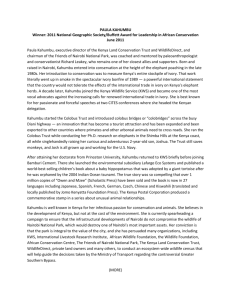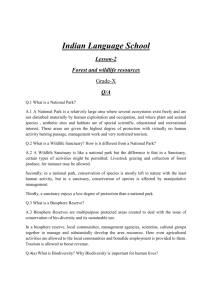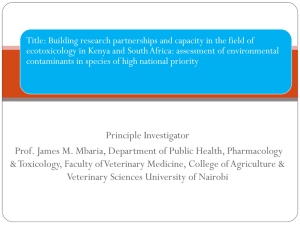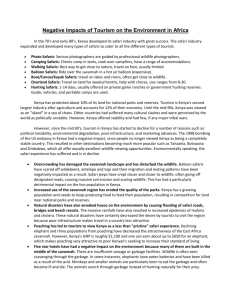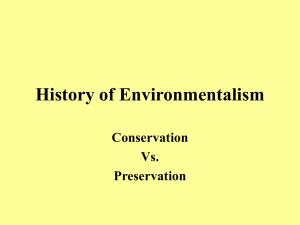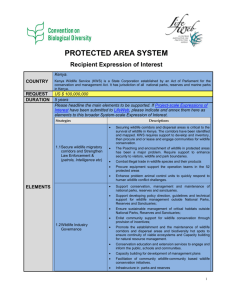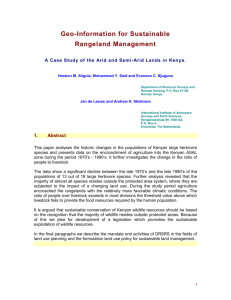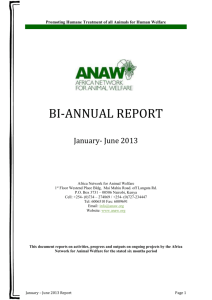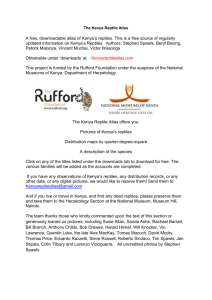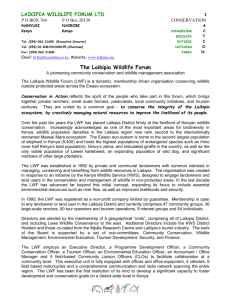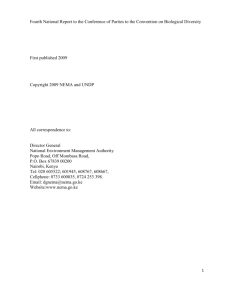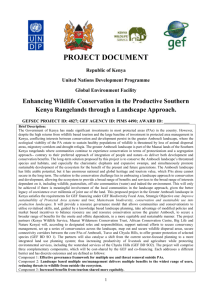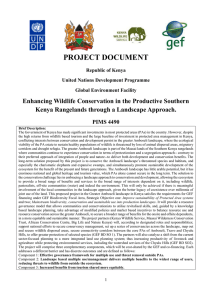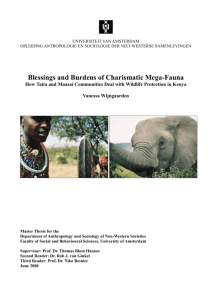workshop on incentive measures for conservation of biodiversity
advertisement
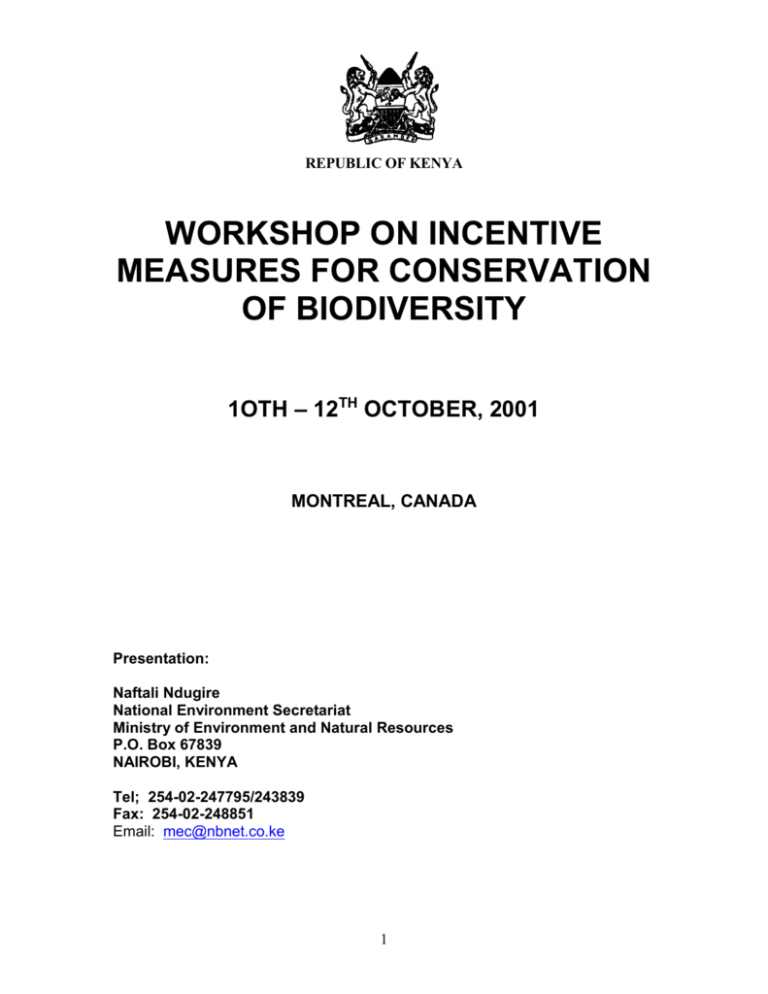
REPUBLIC OF KENYA WORKSHOP ON INCENTIVE MEASURES FOR CONSERVATION OF BIODIVERSITY 1OTH – 12TH OCTOBER, 2001 MONTREAL, CANADA Presentation: Naftali Ndugire National Environment Secretariat Ministry of Environment and Natural Resources P.O. Box 67839 NAIROBI, KENYA Tel; 254-02-247795/243839 Fax: 254-02-248851 Email: mec@nbnet.co.ke 1 1.0 INTRODUCTION Kenya has physical and biological resources that are of considerable domestic and international economic values. It is estimated that the country has 35,000 known species of animals, plants and micro-organizers. This wealth is fundamental to Kenya’s economic prosperity in many ways, for example, as source of income for daily subsistence, source of employment and foreign exchange earnings. This resources and their associated ecosystems are increasingly under pressure from unsustainable use resulting in depletion, pollution, soil erosion etc. Biological resources and their diversity generate a wide range of benefits for human populations, both within the country and at regional and global levels. Simultaneously the conservation of biological resources and their diversity give rise to economic costs. These economic benefits and costs of biodiversity are often not fully recognized when either conservation or development decisions are made. Conservationists more often than not concentrate on costs (as disincentives) and benefits (as incentives). 2.0 KENYA EXAMPLES MEASURES IN THE APPLICATION OF INCENTIVE The starting point in examining the case of Incentive Measures certain parameters are important e.g politics, welfare, geography, social and economic status of the citizens. But more so stakeholders issues are important in putting adequate incentives in place. a) Stakeholder Issues Property rights Protected Areas Other land (Adjudicated or not) Wildlife Externalities From enforcing property rights GOK denies pastoralists access to grazing resources, raises their costs of production (competition, defensive activities, avoidance), increases the costs of development Pastoralists, through modern methods of production, can reduce conservation values, and deny access to tourists. Ethical Issues Do traditional users of land have to right to benefit from the development potential of their land? 2 Corollary: should they be compensated if that right is denied to them? Opportunity Costs Optimization b) Foregone benefits of development How much is enough? How many wildebeest do you need – and for what? The economic benefits of biological resources and their diversity The total economic cost of biological resources and their diversity to Kenya Economic analysis of Kenya’s major economic sectors and ecosystems identified various costs imposed on economic activities as a result of biodiversity: 3 Economic Costs ECONOMIC COSTS Other Activities Management c) Agricultural Lands Forests Marine and Coastal Wetlands Wildlife areas Farm labour, equipment and inputs, MoA/KARI expenditure Pests, disease and interbreeding with other varieties FD/KEFRI/Private management expenditure Damage to crops, livestock and humans from forest dwelling animals KWS/Fisheries/KEMFRI/ Private management expenditures Damage to humans from marine fish and mammals Damage to crops, livestock and humans from wetland dwelling animals, water-borne and water related disease KWS/private management expenditure Damage to crops, livestock and human injury and disease, competition for pasture form wildlife KWS/private management expenditures 4 Opportunity Exclusion of exotic monocroping Exclusion of agriculture, exotic plantations, unsustainable land developments and resource uses Exclusion of unsustainable resources uses and marine developments Exclusion of agriculture, ranching, unsustainable land developments and resources uses Exclusion of agriculture, ranching, unsustainable land developments and resources uses Examples Arabuko – Sokoke Forest (i) (ii) - Recognized as the largest remaining block of coastal forests in E. Africa recognized as the second most important forest for bird conservation on the African Continent. - Farmers involved in larvae raising for butterflies exportation on commercial basis - revenues and income generated - farmers are therefore willing to conserve the diversity of biological resources of Arabuko – Sokoke forest. Eco-Tourism and Wildlife Does Ecotourism Protect Wildlife? The table below shows the flows of wildlife generated benefits in four districts in Kenya DISTRICT Loss of Wildlife (% over 20 years) Population Growth (% pa) Agricultural Potential Tourist Numbers Wildlife Management NAROK -55% SAMBURU KAJIADO LAIKIPIA -24% 0% +3% +6.59 +++ 138,000 County Council +3.54 (+) 90,000 County Council +5.67 + 168,000 Kenya Wildlife Service +4.99 + 5,000 Private Landowners Tour Operators Government County Council +++ (+) +++ +++ (+) +++ +++ ++ 0 0 (+) 0 LANDOWNERS (+) (+) ++ +++ FLOW OF REVENUES:- III) TOURISM Lake Victoria and Wise Use of Wetlands Papyrus reeds 5 Cottage industries (weaving, basketry etc) No policy of Incentives yet although recognized in the National Biodiversity Strategy and Action Plan. 6
